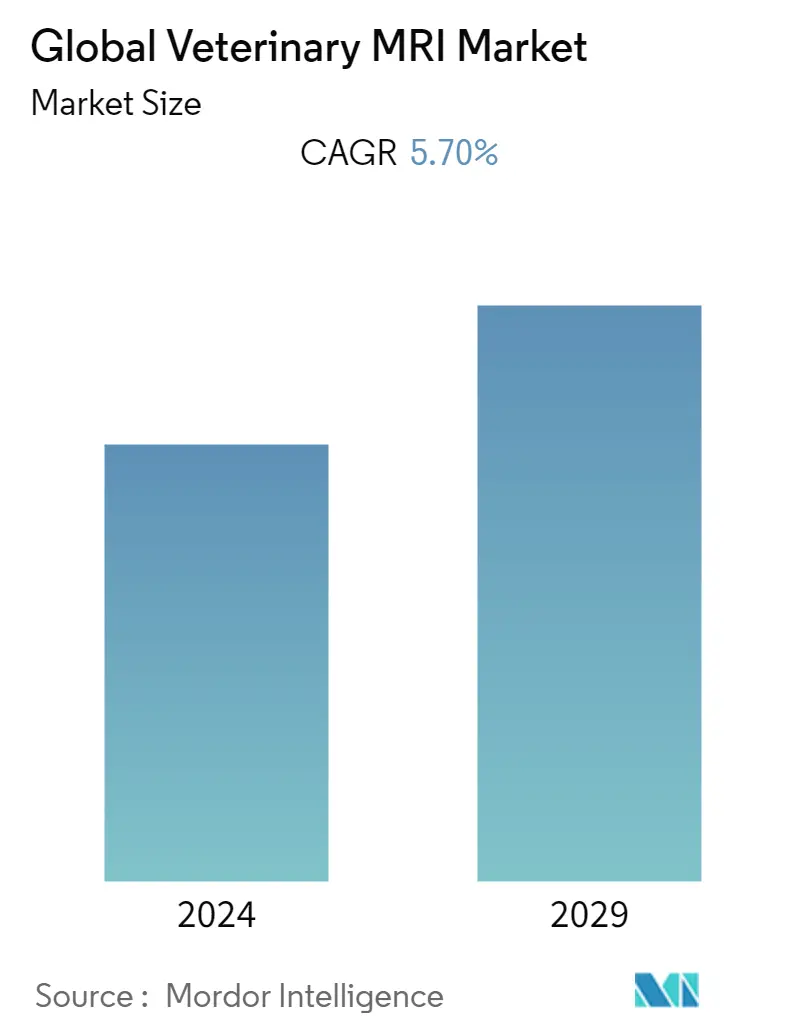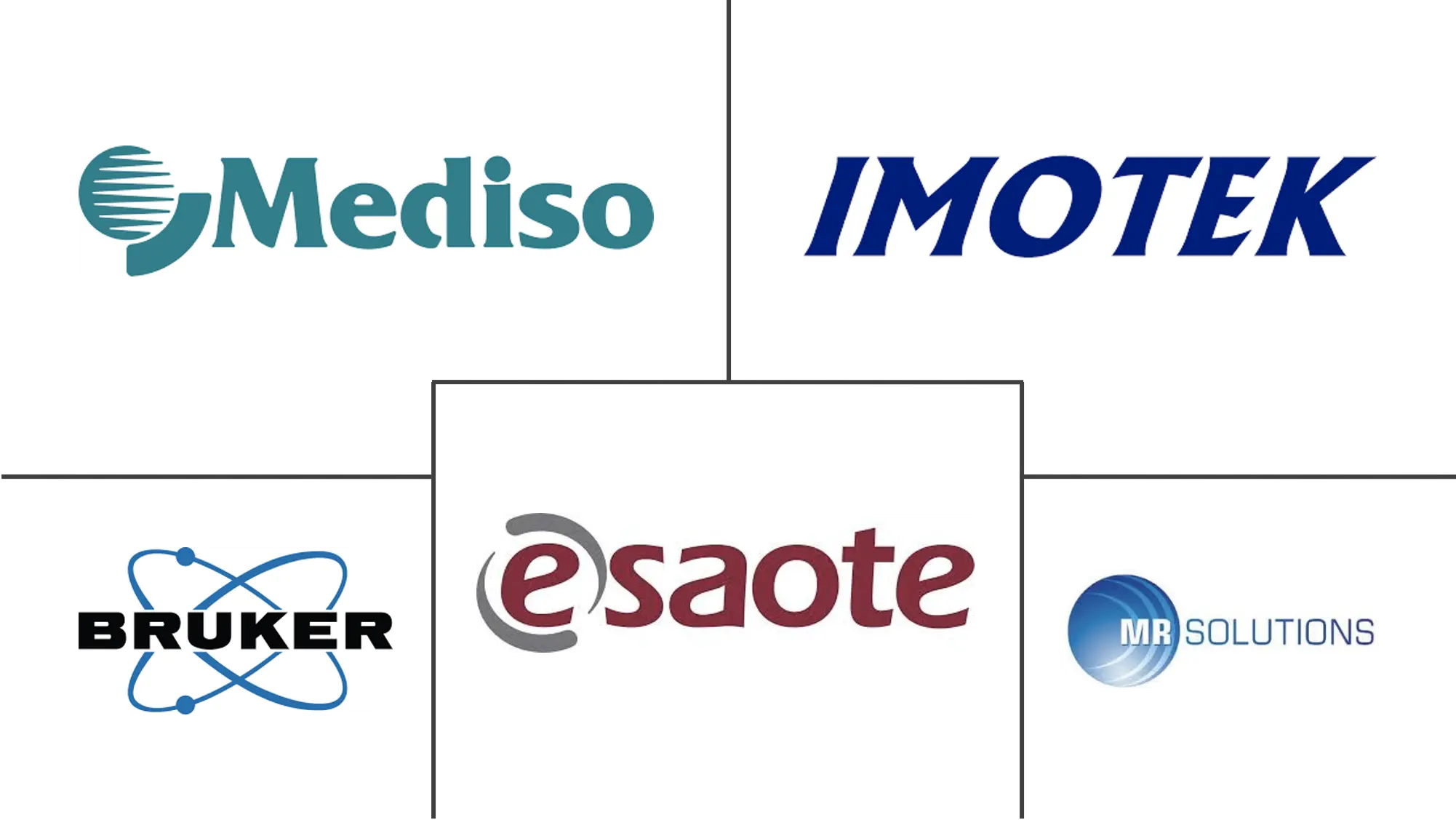Market Size of Global Veterinary MRI Industry

| Study Period | 2019 - 2029 |
| Base Year For Estimation | 2023 |
| CAGR | 5.70 % |
| Fastest Growing Market | Asia Pacific |
| Largest Market | North America |
| Market Concentration | Medium |
Major Players
*Disclaimer: Major Players sorted in no particular order |
Veterinary MRI Market Analysis
The veterinary MRI market is expected to witness a CAGR of 5.7% over the forecast period.
The supply chain was disrupted, leading to difficulty in moving animal products, such as meat, milk, and eggs to markets. However, catering to the disrupted demand-supply chain, the Food and Agriculture Organization, in April 2020, published a new policy regarding the production of livestock and the supply chain of livestock products during the pandemic to ensure sufficient production of livestock. In May 2020, Animal Health Europe announced the European Commission adding veterinary medicines to the ''Communication for the Implementation of the Green Lanes under the Guidelines for Border Management Measures'', to protect health and ensure the availability of goods and essential services for the stable supply of safe, nutritious food and protection of pets during the pandemic. Therefore, the pet cancer therapeutics market was affected too much by lockdowns and restrictions. A new article by the Nature Conservancy of Canada in April 2022 showed that there had been an increase in the demand for dog services on the Prince Edward Island of Canada, as the COVID restrictions began to ease off. The article indicated that the dog care business in the region has almost doubled in the previous two months for certain pet care facilities. This increase in pet care after the COVID-19 pandemic will positively impact the studied market in the forecast period.
The market for veterinary MRI is expected to grow over the forecast period, which is majorly attributed to the increasing awareness about veterinary healthcare and the growing pet ownership along with rising expenditure on veterinary health. The past few years have observed a significant rise in the adoption of companion animals, including dogs and cats. Cattle and swine were adopted for various commercial purposes. According to the American Society for the Prevention of Cruelty to Animals (ASPCA), every year, around 6.5 million companion animals enter animal shelters countrywide in the United States. Out of these animals, approximately 3.3 million are dogs. They also estimated that 3.2 million shelter animals are adopted as pets every year, among which 1.6 million are dogs. The American Pet Products Association (APPA) stated in its 2020 report that 68% of US households (or approximately 85 million families) own a pet. The survey also revealed that the total expenditure on pets in the United States was approximately USD 103.6 billion in 2020. According to the report, about 90 million dogs are owned in the United States. Hence, the rise in pet ownership indirectly generates a rise in the demand for proper diagnosing of various diseases that can help treat these animals, which is further expected to propel the growth of the market studied over the forecast period.
However, the high cost of MRI systems and lack of skilled veterinarians are expected to hinder the market growth.
Veterinary MRI Industry Segmentation
As per the scope, magnetic resonance imaging is a medical imaging technique, which is used in radiology to produce pictures of the anatomy and the physiological processes of the body in both health and disease. These pictures are further used to diagnose and detect the presence of abnormalities in the body. Veterinary MRIs are specially designed to diagnose abnormalities in animals. The veterinary MRI market is segmented by product type (MRI systems, imaging software, and others), application (cardiology, oncology, neurology, orthopedics, and other applications), animal type (small animals, and large animals), and geography (North America, Europe, Asia-Pacific, Middle-East and Africa, and South America). The market report also covers the estimated market sizes and trends for 17 different countries across the major regions globally. The report offers the values (USD million) for the above segments.
| By Product Type | |
| MRI Systems | |
| Imaging Software | |
| Others |
| By Application | |
| Cardiology | |
| Oncology | |
| Neurology | |
| Orthopedics | |
| Other Applications |
| By Animal Type | |
| Small Animals | |
| Large Animals |
| Geography | ||||||||
| ||||||||
| ||||||||
| ||||||||
| ||||||||
|
Global Veterinary MRI Market Size Summary
The veterinary MRI market is poised for growth, driven by increasing awareness of veterinary healthcare and a rise in pet ownership, which is accompanied by higher spending on veterinary health. The adoption of companion animals, such as dogs and cats, has seen a significant uptick, with cattle and swine also being adopted for commercial purposes. This surge in pet ownership has led to a heightened demand for effective disease diagnosis and treatment, thereby propelling the market forward. Despite challenges such as the high cost of MRI systems and a shortage of skilled veterinarians, the market is expected to expand, supported by the growing need for advanced medical imaging to address various animal health issues, including cardiac diseases.
North America is anticipated to maintain a substantial share of the veterinary MRI market, fueled by increasing pet adoption and higher per capita animal healthcare expenditure. The region's market growth is further bolstered by the rising prevalence of animal diseases and injuries. The market landscape is moderately competitive, with both global and local companies striving to enhance their product offerings through technological advancements. Notable players in the market include Esaote SpA, Bruker Corporation, and Mediso Ltd., among others. Recent developments, such as the launch of new veterinary urgent care clinics and strategic partnerships, underscore the dynamic nature of the market, which continues to evolve in response to changing consumer demands and technological innovations.
Global Veterinary MRI Market Size - Table of Contents
-
1. MARKET DYNAMICS
-
1.1 Market Overview
-
1.2 Market Drivers
-
1.2.1 Increased Pet Ownership and Initiatives for Animal Health
-
1.2.2 Technological Advancements in Veterinary Imaging
-
-
1.3 Market Restraints
-
1.3.1 High Cost of MRI Systems
-
1.3.2 Lack of Skilled Veterinarians
-
-
1.4 Industry Attractiveness - Porter's Five Forces Analysis
-
1.4.1 Bargaining Power of Suppliers
-
1.4.2 Bargaining Power of Consumers
-
1.4.3 Threat of New Entrants
-
1.4.4 Threat of Substitute Products
-
1.4.5 Intensity of Competitive Rivalry
-
-
-
2. MARKET SEGMENTATION (Market Size by Value - USD million)
-
2.1 By Product Type
-
2.1.1 MRI Systems
-
2.1.2 Imaging Software
-
2.1.3 Others
-
-
2.2 By Application
-
2.2.1 Cardiology
-
2.2.2 Oncology
-
2.2.3 Neurology
-
2.2.4 Orthopedics
-
2.2.5 Other Applications
-
-
2.3 By Animal Type
-
2.3.1 Small Animals
-
2.3.2 Large Animals
-
-
2.4 Geography
-
2.4.1 North America
-
2.4.1.1 United States
-
2.4.1.2 Canada
-
2.4.1.3 Mexico
-
-
2.4.2 Europe
-
2.4.2.1 United Kingdom
-
2.4.2.2 Germany
-
2.4.2.3 France
-
2.4.2.4 Italy
-
2.4.2.5 Spain
-
2.4.2.6 Rest of Europe
-
-
2.4.3 Asia-Pacific
-
2.4.3.1 China
-
2.4.3.2 Japan
-
2.4.3.3 India
-
2.4.3.4 Australia
-
2.4.3.5 South Korea
-
2.4.3.6 Rest of Asia-Pacific
-
-
2.4.4 Middle-East and Africa
-
2.4.4.1 GCC
-
2.4.4.2 South Africa
-
2.4.4.3 Rest of Middle-East and Africa
-
-
2.4.5 South America
-
2.4.5.1 Brazil
-
2.4.5.2 Argentina
-
2.4.5.3 Rest of South America
-
-
-
Global Veterinary MRI Market Size FAQs
What is the current Global Veterinary MRI Market size?
The Global Veterinary MRI Market is projected to register a CAGR of 5.70% during the forecast period (2024-2029)
Who are the key players in Global Veterinary MRI Market?
Esaote SpA, Bruker Corporation, Mediso Ltd., MR Solutions and Imotek International Ltd are the major companies operating in the Global Veterinary MRI Market.

